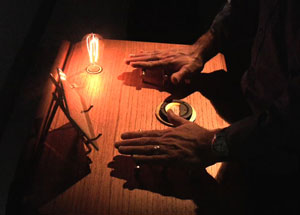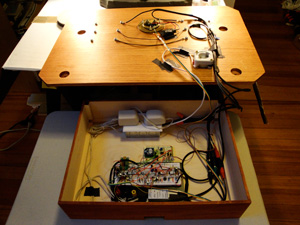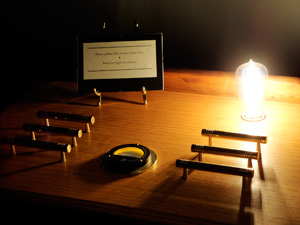the Biometric Table (2009)
The Biometric Table uses several sensing methods to generate sound and image from a participant's physical activity. The project, part of my installation Let us imagine a straight line, combines 21st-century technology with 19th-century aesthetics, in order to create an interactive interface that recalls the precision and artisanship of the instruments created during the heyday of the scientific revolution.
Three physical aspects of each participant are sensed: proximity via infrared, touch via capacitance sensing, and heart rate via a custom-built EKG interface. As the viewer approaches the unit, a proximity sensor awakens the machine, turning on the meter backlight and initiating the first layer of sonic activity. The meter is a custom-made device that mimics the type of visual display found on early scientific instruments.
 When participants place their hands across the two rows of brass sensors, their touch is sensed and another sonic layer activates. The brass sensors are also the EKG interface, and as soon as the participant touches them the EKG calculation begins. Data is transmitted wirelessly to a remote computer, where heart rate calculation takes place. As the computer calculates the heart rate, data is sent back to the Biometric Table to activate the meter, showing a calculation in progress.
When participants place their hands across the two rows of brass sensors, their touch is sensed and another sonic layer activates. The brass sensors are also the EKG interface, and as soon as the participant touches them the EKG calculation begins. Data is transmitted wirelessly to a remote computer, where heart rate calculation takes place. As the computer calculates the heart rate, data is sent back to the Biometric Table to activate the meter, showing a calculation in progress.
 When the EKG calculation is complete, the Biometric Table receives data from the remote computer to activate the vintage light bulb (a recreation of an 1892 Edison bulb). At the same moment the remote computer uses the Biometric Table data to generate video and sound events: on the dual-screen projection participants watch a waveform of their heart beat combined with other images; the sonic events include audio of their own heart beat.
When the EKG calculation is complete, the Biometric Table receives data from the remote computer to activate the vintage light bulb (a recreation of an 1892 Edison bulb). At the same moment the remote computer uses the Biometric Table data to generate video and sound events: on the dual-screen projection participants watch a waveform of their heart beat combined with other images; the sonic events include audio of their own heart beat.
For an example of the Biometric Table in action, see Let us imagine a straight line, installation no. 2.)
